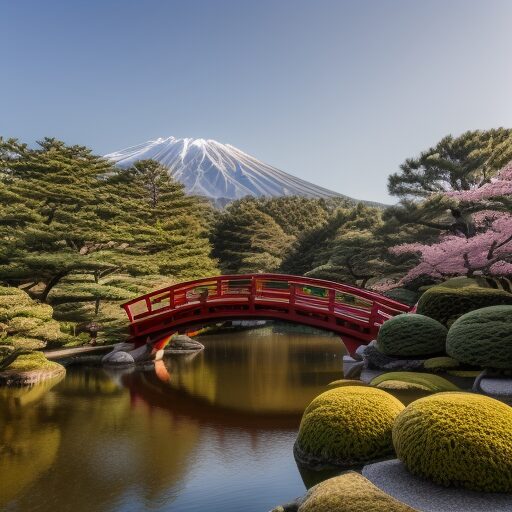Imagine strolling through a serene Japanese garden, surrounded by vibrant colors, fragrant flowers, and the gentle sound of water flowing beneath your feet. As you wander along the winding pathways, you come across a beautifully crafted garden bridge, its elegant design seamlessly blending into the natural landscape. In that moment, you find yourself transported to a world where reality merges with dreams, where tranquility and harmony reign supreme. Japanese garden bridges not only serve as practical crossings, but they also bridge the gap between reality and reverie, creating an enchanting experience that captivates the senses and nourishes the soul.
Design and Purpose of Japanese Garden Bridges
Japanese garden bridges are meticulously designed to serve both aesthetic and functional purposes in traditional Japanese gardens. These bridges are an integral part of the overall design, creating a tranquil environment that harmonizes with nature and carries symbolic meanings.
Creating a Tranquil Environment
One of the primary aims of a Japanese garden is to provide a serene and tranquil space for contemplation and relaxation. The design of the Japanese garden bridges plays a crucial role in achieving this goal. The gentle curves and graceful lines of the bridges instill a sense of peace and tranquility, inviting you to cross over and explore the garden beyond.
Harmony with Nature
Japanese gardens are carefully designed to blend seamlessly with the surrounding natural landscape. The bridges, with their organic shapes and natural materials, enhance this harmony. By using materials such as wood, stone, and bamboo, Japanese garden bridges become an extension of the natural world, effortlessly connecting the different elements of the garden.
Symbolic Meanings
Japanese culture places great significance on symbolism, and Japanese garden bridges are no exception. These bridges often represent the journey of life, acting as a crossing point between different areas of the garden. They symbolize transition, passage, and the exploration of new experiences. Crossing a Japanese garden bridge can be seen as a metaphorical journey, offering a deeper connection to the surrounding landscape and an opportunity for introspection.
Different Types of Japanese Garden Bridges
Japanese garden bridges come in various designs, each with its own unique characteristics and visual appeal.
Arched Bridges
Arched bridges, also known as “taikobashi,” are among the most common types of bridges in Japanese gardens. The arched shape allows for a gentle slope, making them easy to traverse. These bridges often feature intricate wooden or bamboo lattice work, adding an additional layer of beauty to their design.
Flat Bridges
Flat bridges, or “hirabashi,” have a simpler and more minimalist design compared to arched bridges. They are typically made of sturdy wooden planks that lay flat across the water or landscape. These bridges blend seamlessly with the garden, offering a sense of understated elegance.
Moon Bridges
Moon bridges, or “tsukubai,” are iconic features of Japanese garden design. These bridges curve in a semicircular shape, resembling the shape of the moon. Moon bridges often span over ponds, creating a picturesque reflection in the water. They evoke a peaceful and mystical atmosphere, inviting you to step into a dreamlike realm as you cross over.

Materials Used in Japanese Garden Bridges
Japanese garden bridges are crafted using a selection of traditional materials, each chosen for their durability and aesthetic appeal. The choice of material contributes to the overall ambiance of the garden.
Wooden Bridges
Wooden bridges are a popular choice in Japanese garden construction, as they blend harmoniously with the natural surroundings. The warmth and organic texture of wood create a welcoming and timeless aesthetic. Cedar, cypress, and teak are commonly used due to their strength, resistance to decay, and ability to withstand the test of time.
Stone Bridges
Stone bridges, often made from granite or basalt, bring a sense of permanence and solidity to a Japanese garden. The natural texture and earthy tones of the stones complement the surrounding landscape, creating an atmosphere of timeless beauty. Stone bridges are known for their sturdiness, making them a long-lasting choice even in harsh weather conditions.
Bamboo Bridges
Bamboo bridges add a touch of lightness and delicacy to a Japanese garden. The slender and flexible nature of bamboo creates an airy and graceful aesthetic. While not as robust as wooden or stone bridges, bamboo bridges can still withstand moderate weight and offer a unique and charming element to the garden design.
Features and Characteristics
Japanese garden bridges possess several distinct features and characteristics that contribute to their visual appeal and integration within the garden.
Natural and Organic Shapes
Japanese garden bridges are designed to mimic the curves and flow of nature. Instead of rigid angles and straight lines, these bridges embrace organic and flowing shapes, seamlessly blending with the natural contours of the garden. The soft arcs and gentle slopes of the bridge enhance the overall harmony and tranquility of the landscape.
Simple and Unadorned
Japanese aesthetics prioritize simplicity and the elimination of unnecessary elements. This principle is embodied in the design of Japanese garden bridges, which often have clean lines and minimal ornamentation. The focus is on the natural beauty of the materials and the surrounding landscape, allowing the bridges to complement rather than overpower the overall garden design.
Incorporating Water Elements
Water is an essential element in Japanese garden design, and bridges often span over ponds, streams, or water features. By incorporating water elements, the bridges create a visual connection and a sense of harmony between land and water. The reflection of the bridge in the water adds depth and serenity to the overall garden composition.
Intimate Connection to the Surrounding Landscape
Japanese garden bridges are carefully positioned to create a connection between different areas of the garden. They serve as a link, inviting you to explore and wander through the various elements, such as rock formations, carefully pruned trees, and meticulously raked gravel. The placement of the bridges is calculated to enhance the overall flow and navigation within the garden, ensuring a seamless and immersive experience.

Importance of Water in Japanese Garden Bridges
Water plays a crucial role in the design and symbolism of Japanese garden bridges. Its presence adds depth, movement, and reflective surfaces, enhancing the overall aesthetics and meaning of the bridge.
Bridging the Gap between Land and Water
Japanese garden bridges act as a physical bridge, allowing you to traverse from one side of the water to the other. They symbolize the connection between different realms and emphasize the seamless integration of human-made structures with the natural world. As you cross the bridge, you are metaphorically bridging the gap between land and water, entering a space where the boundaries between the two become blurred.
Reflective Surfaces
The presence of water beneath a Japanese garden bridge adds an element of reflection. The still and mirror-like surface of the water captures the beauty of the bridge and its surroundings, creating a captivating visual effect. Reflective surfaces heighten the sense of tranquility and provide an opportunity for contemplation and self-reflection.
Flow and Movement
Water is in constant motion, and by incorporating it into the design of Japanese garden bridges, a sense of movement is achieved. The flowing water underneath the bridge adds a dynamic element, creating a contrast to the stillness of the bridge itself. This interplay between stillness and motion reflects the ever-changing nature of life and encourages a sense of mindfulness and appreciation of the present moment.
Symbolic Meanings of Japanese Garden Bridges
Japanese culture places great importance on symbolism, and Japanese garden bridges carry significant meaning beyond their practical function.
Transition and Passage
Japanese garden bridges symbolize the act of crossing from one place or state to another. They represent a transition or passage, both literally and metaphorically. Crossing a bridge can signify embarking on a new chapter in life, overcoming obstacles, or venturing into the unknown. Japanese garden bridges encourage you to embrace change, accept transitions, and experience personal growth.
Journey and Exploration
Like a bridge spanning a river, Japanese garden bridges symbolize a journey. They invite you to embark on an exploration of the garden and its hidden treasures. Crossing a bridge becomes a miniature adventure, allowing you to immerse yourself in the beauty of the surroundings and discover new perspectives. The journey is as important as the destination, and each step across the bridge brings you closer to uncovering the secrets of the garden.
Connection and Unity
Japanese garden bridges act as a unifying element, bringing together different parts of the garden. They facilitate the connection between various elements, such as islands, paths, and water features, creating a harmonious and cohesive whole. Symbolically, bridges represent the connection between people, cultures, and experiences. They remind us of the importance of unity and finding common ground in our interconnected world.

Artistry and Craftsmanship
Japanese garden bridges exemplify the exquisite artistry and craftsmanship inherent in traditional Japanese culture. The meticulous attention to detail and the use of traditional techniques contribute to the enduring beauty of these bridges.
Precision and Attention to Detail
The construction of Japanese garden bridges requires precision and meticulous craftsmanship. Every joint is carefully fitted, ensuring structural integrity and a seamless appearance. Traditional craftsmen take great pride in their work, meticulously shaping and finishing each piece with utmost care. The result is a bridge that not only serves its purpose but also becomes a work of art in its own right.
Incorporating Traditional Techniques
Japanese garden bridges often incorporate traditional woodworking techniques that have been passed down through generations. Mortise and tenon joinery, intricate lattice work, and carefully hand-carved details are hallmarks of Japanese craftsmanship. By using these time-honored techniques, the bridges pay homage to the rich cultural heritage and celebrate the unique artistry of Japanese woodworking.
Balance and Proportion
Japanese aesthetics emphasize finding harmony and balance in design. Japanese garden bridges embody this principle, with their carefully considered proportions and balanced form. The materials, size, and weight of the bridge are all taken into account to create a bridge that not only blends seamlessly with the landscape but also feels visually and physically balanced. The result is a bridge that is not only functional but also visually appealing from every angle.
Maintenance and Care of Japanese Garden Bridges
To ensure the longevity and authenticity of Japanese garden bridges, proper maintenance and care are essential. By following certain practices, these bridges can continue to be enjoyed for generations to come.
Protection from Weathering
Japanese garden bridges are exposed to the elements, which can cause weathering over time. By applying protective coatings or stains, the wood can be shielded from the effects of sun, rain, and snow. Regular inspections can help identify any signs of wear or damage, allowing for timely repairs and restoration.
Regular Cleaning and Inspections
Keeping Japanese garden bridges clean is crucial to their preservation. Regular cleaning removes debris, algae, and moss, preventing them from causing deterioration. Inspections should also be carried out periodically to identify any structural issues or potential hazards. By addressing these concerns promptly, the integrity and safety of the bridges can be maintained.
Preserving Authenticity
Preserving the authenticity of Japanese garden bridges means respecting the traditional craftsmanship and materials used in their construction. Avoiding modifications or alterations that compromise the original design is important to maintain the bridge’s cultural value. By preserving the original features and materials, the bridge continues to tell a story and serves as a testament to the rich heritage of Japanese garden design.
The Role of Japanese Garden Bridges in Meditation and Contemplation
Japanese garden bridges go beyond being mere decorative elements. They play a significant role in creating an environment conducive to meditation, contemplation, and finding inner peace.
Creating a Sense of Serenity
Japanese garden bridges are designed to instill a sense of serenity in those who cross them. The peaceful surroundings and the gentle sound of flowing water create a calming atmosphere. As you walk across the bridge, you can take in the beauty of the garden, leaving behind the stresses and worries of everyday life. The bridge becomes a gateway to tranquility and inner reflection.
Aiding in Mindfulness Practices
Mindfulness is an essential practice in Japanese culture, and the presence of Japanese garden bridges facilitates this state of being. Crossing a bridge provides an opportunity to focus on the present moment, heightening your awareness of the surroundings and your own thoughts and emotions. By immersing yourself in the sensory experiences, such as the feel of the wood beneath your feet and the sounds of nature, you can cultivate mindfulness and deepen your connection to the present.
Inspiring Reflection and Inner Peace
Japanese garden bridges encourage introspection and self-reflection. As you cross the bridge, the reflection in the water invites you to contemplate your own reflections and inner thoughts. The peaceful atmosphere and natural beauty inspire contemplation and can lead to a sense of inner peace and harmony. Japanese garden bridges provide a sanctuary for introspection and offer an opportunity to find solace in the midst of a bustling world.
Famous Japanese Garden Bridges
Throughout Japan, several famous garden bridges have become iconic symbols of Japanese culture and craftsmanship.
The Bridge at Ritsurin Garden
Located in Takamatsu, Kagawa Prefecture, Ritsurin Garden is renowned for its serene beauty and meticulous design. The garden features a stunning wooden arched bridge that spans over a tranquil pond. This bridge exemplifies the elegance and harmony that Japanese garden bridges are known for, providing a picturesque backdrop for visitors to enjoy.
The Moon Bridge at Kameido Tenjin Shrine
Situated in Tokyo, Kameido Tenjin Shrine is famous for its breathtaking moon bridge, known as “soribashi.” This unique bridge arches gracefully over a pond filled with vibrant purple wisteria blossoms. During the spring season, the combination of the elegant bridge and the striking floral display creates a scene of ethereal beauty.
Taiko Bridge at Kanazawa Castle
Kanazawa Castle in Ishikawa Prefecture is home to the stunning Taiko Bridge. This impressive stone bridge spans over a moat, accentuating the majestic presence of the castle. With its solid structure and historical significance, the Taiko Bridge represents the grandeur and resilience of Japanese architecture.
In conclusion, Japanese garden bridges are carefully designed to create a tranquil and harmonious environment within traditional Japanese gardens. With their aesthetic appeal, symbolic meanings, and connection to nature, these bridges serve as an invitation to explore, reflect, and find inner peace. Through meticulous craftsmanship, incorporation of traditional techniques, and careful maintenance, Japanese garden bridges continue to bridge the gap between reality and reverie, preserving the beauty and cultural heritage of Japan for generations to come.








